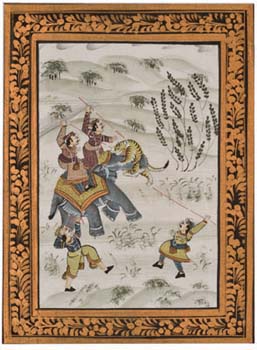Tiger Hunt
- 19th century
- Artish unknown, Mughal (or Mogul) style, India
- Gouache or casein on fabric
29.5 x 21.8 cm., 11-5/8 x 8-5/8"
- Catherine Carter Goebel, Paul A. Anderson Chair in the Arts Purchase, Paul A. Anderson Art History Collection, Augustana College 2011.2.1

Essay by Pareena G. Lawrence, Former Provost and Dean of the College, Professor of Economics
The Mughal dynasty ruled over the Indian subcontinent from the sixteenth century to the mid-eighteenth century. This dynasty was founded by Babur who belonged to the house of Timur and was a descendant of Genghis Khan. Babur came to the Indian subcontinent from the small Central Asian state of Fergana (modern Uzbekistan). He began his travel to the east in 1504, and after a long and enduring conquest of India, by 1527 Babur was able to lay the foundation of what was to become the Mughal empire. Babur's grandson Akbar, known as the architect of the Mughal empire and its greatest emperor, fortified this empire by gaining control over northern, western and central India and securing the northwestern border (modern Afghanistan) which had been the gateway to India for many previous invasions (including those led by Alexander the Great and Genghis Khan). Akbar established a strong civil administrative system, was extremely tolerant of other religions and is considered the first great Mughal patron of the arts (Department of Islamic Art). His son Jahangir ascended the throne after Akbar's death and continued to patronize the arts, adding his own unique and strong artistic preferences. Jahangir's son, Shah Jahan, ascended the throne in 1628 and continued the patronage of the arts, and is best known for his architectural accomplishment, the Taj Mahal. Shah Jahan's reign was forcibly ended in 1658 by his son Aurangzeb, who followed extremely orthodox religious beliefs, and his reign saw the beginning of the decline of Mughal patronage of the arts and ultimately the decline and demise of the Mughal empire which was succeeded by the British empire in India (Sarder).
Babur's son, Humanyun, introduced the Mughal style of painting to India that was inspired by Persian art but (over time) incorporated Indian and Islamic styles and added new themes and colors. Mughal paintings often depict historical events, court life, stories and legends, hunting scenes, wildlife and portraits. Most Mughal paintings were commissioned and were confined mainly to book illustrations and miniatures. Earlier periods of Mughal paintings used a team of artists, similar to Western workshops, where each artist played a different role in the process of completing the work of art, such as determining composition, coloring, and delineating distinctive faces. Later, individual artists were commissioned to complete an entire painting. Artists were Persians as well as Indian Muslims and Hindus. This collaborative process helped to foster the development of a specifically Mughal style of painting distinctly different from the Persian style (Sarder). This style of painting was further developed and refined during the reigns of Akbar's heirs. In many Mughal paintings, a single frame could depict multiple scenes and narrate different events. In the later phase, Mughal art was influenced by Western art and started using light and shade to create the illusion of space and volume (Beach 39-110).
The two 19th-century Mughal paintings that are part of the Augustana collection are on silk and each narrates a single event. The borders are painted in gold with a floral motif. The first of the two paintings (72B) represents Hindu Lord Krishna, characteristically blue-skinned, and his consort Radha in conversation with three women who are carrying water on their heads at dusk. The artist(s) have used bright blue and pink colors and paid attention to details such as necklace, anklets, bangles, earrings, head jewelry and eyelashes.
The second painting (72A) depicts a tiger attacking an elephant during a tiger hunt in the semi-arid setting of Western India. The action is furthered through the incorporation of three men armed with spears as well as one with a bow and arrows. The colors chosen by the artist(s) reflect earth tones and show exceptional details in the facial features, clothing and jewelry worn by the soldiers and royalty. These works eloquently illustrate the later phase of Mughal art, evidenced by traditional Eastern subject matter as it was impacted by Western illusionistic characteristics and the Rajasthani style of painting that became increasingly dominant in north India in the eighteenth and nineteenth centuries.
